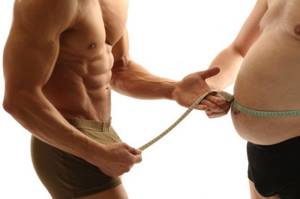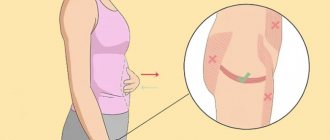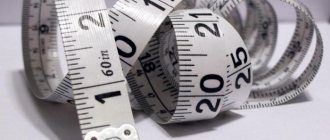How does waist size affect your health?
Normally, a man’s waist circumference should be no more than 94 cm. Even exceeding this figure to 100 cm is a sign of excess fat. A waist circumference greater than 102 cm indicates obesity.
Even if the weight remains within the acceptable range, excess fat deposits around the waist negatively affect health and life expectancy. Obesity in the abdominal area leads to high cholesterol levels, cardiovascular diseases, and a predisposition to cancer pathologies. This is due to the fact that fat deposits create a high load on internal organs and the musculoskeletal system. Potency often suffers as well. Doctors have concluded that every extra 5 cm of waist circumference shortens a man’s life by about 15-17%.
You can determine whether the size of the waist zone is normal based on the man’s height. The waist should be no more than 1⁄2 of the height in girth. If the ratio is more than 0.53, then this should be alarming. An index of 0.58 indicates obesity.
Men often say that they have a hereditary tendency to develop belly fat. But in most cases this is not the case. Only 25% of a person's body composition is determined by genetics. Everything else depends on the person’s diet and lifestyle.
Most men are far from ideal
Body fat percentage
Body fat percentage is calculated by dividing fat mass by total body mass. Fat in the human body is necessary to maintain normal functioning and is divided into several types.
White fat
White fat is the largest source of energy in the human body and accumulates around organs. Thanks to the production of certain hormones with the help of this fat, the risk of cardiovascular diseases and diabetes is reduced. But, an increased amount of white fat in the body can lead to a constant feeling of hunger and, as a result, to obesity.
According to statistics, a body fat content of 15 to 25% is considered normal for a man, and 15 to 30% for a woman.
Brown fat
The location of brown fat is in the area of the kidneys, shoulders, neck and back. In the adult body, the amount of this fat is small, but it helps with weight loss by helping to expend energy. For example, a person weighing 69 kilograms has approximately 20 to 30 kilograms of fat. Of the total amount, brown fat accounts for only 500 to 800 grams. However, this amount will be enough to lose half a kilogram per week.
Beige fat
Beige fat is a transitional fat that can turn into white fat with regular exercise and help you lose excess weight. If a person is in a low temperature environment, beige fat can transform into brown fat.
Subcutaneous fat
Subcutaneous fat is fat that makes up 90% of the total body fat. Women always have more subcutaneous fat than men. It should also be taken into account that with old age its amount decreases.
Visceral fat
Visceral fat is dangerous to human health. It accumulates around the liver, heart, intestines and other organs. Problems of the cardiovascular system (for example, heart attack and stroke) and a number of other diseases can be caused by excess visceral fat.
Visceral fat can be assessed using the WHR indicator, which was described above.
When estimating your total body fat percentage, you should take into account a person's body type and activity level. For example, at an average level of activity, body fat is considered normal: 18-25% in men and 25-31% in women. For athletes, these figures are reduced by almost 2 times.
Estimating body fat percentage indicates fitness level, but the calculation focuses on the percentage of fat to total body weight. The BMI indicator does not take these nuances into account.
What is abdominal visceral obesity
To understand whether a person suffers from this type of obesity, it is necessary to know the size of the waist and hips. Measurements are taken with an ordinary tailor's centimeter, placing the tape 2 cm above the level of the umbilical line. This is how the waist circumference is measured. Hips are measured at their widest part.
If the ratio of these values is less than 1, then this indicates the absence of abdominal-visceral obesity. If the index exceeds 1, then you should worry about your health.
Obesity can be detected in other ways. To do this, squeeze the fold of fat on your stomach between two fingers. If it is more than 2 cm, then you should seriously think about losing weight.
Abdominal-visceral obesity is most common in men. In this case, fat forms around the internal organs. In the future, this can lead to impaired glucose metabolism and the development of diabetes mellitus. Fat metabolism is also disrupted, which leads to hypercholesterolemia and cardiovascular pathologies.
The following types of fat deposits in the waist area in men can be distinguished:
- Loose belly . This indicates excess fat under the skin.
- Ball-shaped belly . A firm abdominal wall does not mean a lack of fat. In this case, fat accumulations are deposited mainly on the internal organs.
- "Beer Belly" . This also indicates obesity in the area of internal organs. In this case, the stomach has an egg shape.

Abdominal obesity
Most often, such obesity occurs in men after 30-35 years, when testosterone production in the body decreases.
Determination of waist norm
- Measurements are carried out with a minimum amount of clothing or in thin clothing that does not distort the shape and size of the body and does not affect the accuracy of measurements. When determining bust circumference, measurements are taken through a bra without pads, made of thin material that does not have metal or other supports.
- Girths are measured with a centimeter tape. The tape should adhere to the body without deforming the soft tissue by tension.
- Basic measurements for determining size: Neck circumference: Neck circumference, measured 2 cm below the Adam's apple and at the level of the 7th cervical spine;
- Chest circumference: Maximum horizontal circumference measured during normal breathing. The measuring tape passes along the shoulder blades, armpits and chest (protruding points of the mammary glands);
- Bust: (chest for women): Maximum horizontal circumference measured during normal breathing. The person stands straight, the tape passes through the shoulder blades, armpits and protruding points of the mammary glands;
- Waist: The circumference of the natural waistline between the ilia and lower ribs. When measuring, the person breathes normally, stands up straight with a relaxed stomach;
- Hip circumference: Horizontal circumference measured at the fullest point of the buttocks;
- Round the result obtained to the nearest value from the standard range of sizes 80, 84, 88, 92, 96..., while:
- If you rounded down to a smaller size, then clothes with a tight silhouette will fit your figure somewhat more tightly than on a figure whose size is equal to the smaller size (the size to which you rounded up).
If you round up to a larger size, then clothes with a tight silhouette will fit your figure more freely than on a figure whose size is equal to the larger size (the size to which you rounded up).
To determine your size, it is a mistake to rely on the size indicated on the label of the clothes you are wearing, even if they fit you perfectly.

It is important to know:
- To determine the size of clothing belonging to the waist group (skirts, trousers), it is necessary to measure the hip circumference for women, and the waist circumference for men.
- To determine the size of clothing related to the shoulder group (blouses, vests, etc.) for both men and women, it is necessary to measure the chest circumference.
- Hip circumference and waist circumference can affect the final value of your size if their values go beyond the full group laid down by the manufacturer for women's and men's clothing models, respectively.
There are 6 complete groups for women and 5 for men. To determine a complete group, the following parameters are required: height, chest and hip circumference (for women), waist circumference (for men).
So, the first thing you need to do is measure your waist circumference. It's important to do it right. The measurement is carried out with a regular centimeter tape. The girth for measurement is taken not at the level of the navel, but in the middle between the bottom line of the lower rib and the top point of the pelvic bone. Measurements are recorded as you exhale and taken twice. If the measurement values differ by 1 cm, the average result is taken.
What waist circumference should men have? Although an adjustment is made for body height, 102 cm, as noted earlier, is already a problem. We can say that the upper limit should be 94 cm. If a man’s waist exceeds 96 cm, then there is cause for concern. Then the person needs to take action to take control of the situation as soon as possible.
To understand in detail what waist size men should have, you need to consider the “waist-height” index. In short, this index is an indicator that characterizes a person’s physique. The body mass index, which is often used to check the correspondence of weight to height, does not reflect the situation with the physique as correctly as compared to the waist-height index.
The latter is based not on weight, but on waist circumference. Because weight characterizes not only the volume of fat, but consists of different components. This indicator, by the way, is used by athletes, including professional ones. Men actively involved in bodybuilding regularly check their waist size before and after training, as well as during the process.
What waist size should men have for a particular height? Using the waist/height ratio mentioned above, a guy will be able to determine whether his waist size is within the normal range. For this, in addition to a measuring tape, you will also need a calculator. Here you will have to deal with specific numbers.
The data obtained from the measurement in centimeters must be divided by the height in centimeters. The number that comes out as a result of division is the “waist - height” index. How to use these numbers? You can write down the following values for yourself, of course, they differ from the norms for women: the index norm for men is 0.43-0.53.
With an indicator of 0.54 and above, a man can be “diagnosed” as overweight and obese. An indicator of 0.58 means severe obesity. But you should not think that the lower these numbers, the better. For example, an indicator equal to or less than 0.42 may mean severe thinness. A value of 0.35 means pathological thinness and underweight in a man. Therefore, there is a lower limit for this indicator (0.42).
Causes of abdominal-visceral obesity
Most often, waist size increases due to excess nutrition and a passive lifestyle. But other causes of abdominal-visceral obesity can be identified:
- Changes in hormonal levels . At the age of about 40 years, the production of male hormones decreases. Testosterone maintains normal metabolism in the body. As soon as the production of this hormone decreases, the amount of the female hormone estrogen in the body increases. Excess fat appears in the abdominal area. Adipose tissue produces the hormone leptin, which suppresses the function of the male gonads, which causes problems with potency.
- Stress factor . During mental overload, the body begins to accumulate fat, creating reserves. In addition, some men have the habit of relieving stress with large amounts of food and alcohol.
- Age-related changes in body weight . The older a person is, the slower his metabolism works. With a sedentary lifestyle, this can lead to obesity.
- Overeating after quitting smoking . Many men, after giving up a bad habit, begin to lean on fatty, spicy and sweet foods.

Overeating after quitting smoking
It must be remembered that the problem is not only the unaestheticness of a large belly. Extra centimeters on the waist are dangerous to health, and getting rid of them is not so easy.
Other waist circumference measurements
Although the waistline is a key indicator of a person's overall health risk, waist-to-height ratio (WHR) and body mass index (BMI) should be considered.
A 2021 study found that waist circumference and OT to P may be indicators of the risk of high blood pressure (hypertension). Another study in 2021 found that OT to R was more specific than BMI and waist circumference in identifying those with “early health risks.” A person is at higher risk of developing obesity-related diseases if their OT to P is greater than 50%.
To calculate OT to P, measure your waist circumference and height in inches. Then divide your waist circumference by your height and multiply by 100. People who are overweight or obese are at high risk of developing diseases such as heart disease and type 2 diabetes. People of moderate weight are also at greater risk of developing these conditions if they have a large waist circumference.
BMI is another useful anthropometric indicator when it comes to body weight and health. Body mass index is equal to the ratio of body weight in kilograms to the square of height in meters.
The BMI range for most people aged 18-65 is as follows:
- less than 18.5 - underweight
- 18.5-24.9 - healthy weight
- 25-29.9 - overweight
- 30 or more - obesity
BMI does not differentiate between weight as fat or muscle, or the distribution of fat throughout the body. Therefore, in some cases it cannot provide an accurate assessment of a person's health status.
For example, athletes may have a high BMI but are not at high risk for certain diseases. Older people may have a low BMI due to low muscle mass, but they may be at higher risk for heart disease and other diseases.
How to reduce your waist
Reducing belly fat is more difficult than simply losing weight. Often, a man’s weight remains normal, but his waist size significantly exceeds acceptable values. It is possible to remove extra centimeters if you follow the following rules:
- There is no need to go on a strict diet and go on fasting days . This usually backfires. When cells suddenly stop receiving nutrition, they begin to accumulate fat and gain weight. It is better to reduce your diet by about 300 kilocalories. It is useful to change your diet, eat little but often. You need to stop eating foods rich in carbohydrates and animal fats, while vegetable fats can be consumed without restrictions. Separate meals can also be beneficial. This diet will lead to a decrease in the number and volume of fat cells.
- While working out in the gym, you need to pay attention to your abdominal muscles . Exercise forces the body to produce more testosterone, this hormone fights visceral fat deposits. But at the same time, you must eat right, otherwise the fat deposits will not disappear, but will remain under a layer of muscle. It is useful to engage in sports that develop breathing: swimming, martial arts, running, fast walking.
- You need to fight constipation and bloating . This can also cause an increase in waist size. Processed food that lingers in the intestines begins to rot, which causes the formation of gases. You need to regularly do yoga exercises with wave-like movements of the abdomen, thus massaging the internal organs.
Cereals and water
Proper nutrition also includes a sufficient amount of grains. In addition to the fact that cereals provide the body with the necessary nutrients and give a lot of energy, they saturate and make you full for a long time. Eating grains improves digestion. Therefore, porridges made from various cereals are simply irreplaceable in the diet.
In addition, doctors recommend trying separate meals. Adequate water consumption, about 8 glasses every day, will help establish the required metabolism. And this, in turn, is a big step towards reducing fat deposits and a beautiful appearance. Increasing the amount of fiber in your diet will also be helpful in this regard. This is what healthy and wholesome food is all about.










